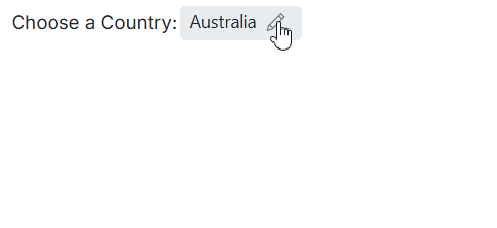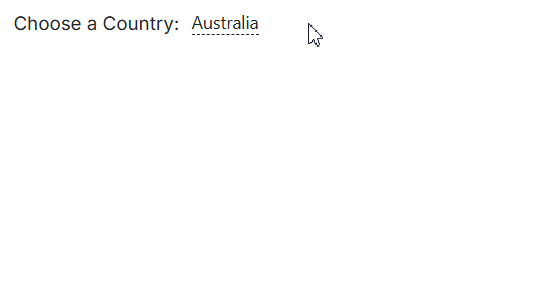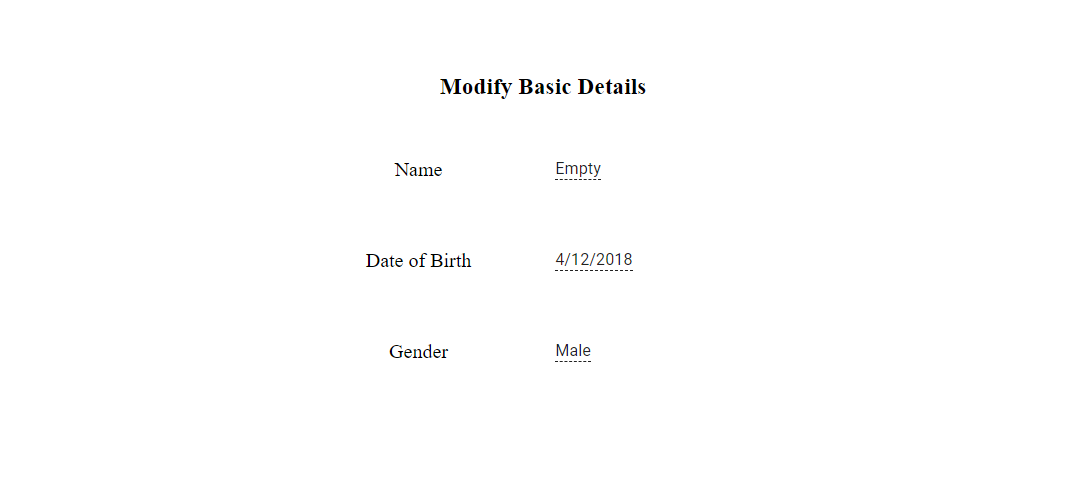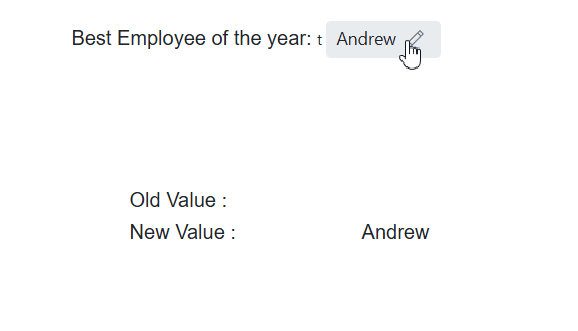Getting Started with Blazor In-place Editor Component
4 Nov 202520 minutes to read
This section explains how to add the Blazor In-place Editor component to a Blazor WebAssembly app using Visual Studio and Visual Studio Code.
To get started quickly with the Blazor In-place Editor in a Blazor WebAssembly app, watch the following video or explore the GitHub sample:
Prerequisites
Create a new Blazor App in Visual Studio
Create a Blazor WebAssembly app using Visual Studio via Microsoft templates or the Syncfusion® Blazor Extension.
Install Syncfusion® Blazor InPlaceEditor and Themes NuGet in the App
To add the Blazor In-place Editor component, open the NuGet Package Manager in Visual Studio (Tools → NuGet Package Manager → Manage NuGet Packages for Solution), then search for and install Syncfusion.Blazor.InPlaceEditor and Syncfusion.Blazor.Themes. Alternatively, use the following Package Manager commands:
Install-Package Syncfusion.Blazor.InPlaceEditor -Version 32.1.19
Install-Package Syncfusion.Blazor.Themes -Version 32.1.19NOTE
Syncfusion® Blazor components are available in nuget.org. Refer to NuGet packages topic for available NuGet packages list with component details.
Prerequisites
Create a new Blazor App in Visual Studio Code
Create a Blazor WebAssembly app using Visual Studio Code via Microsoft templates or the Syncfusion® Blazor Extension.
Alternatively, create a WebAssembly app using the following commands in the terminal(Ctrl+`).
dotnet new blazorwasm -o BlazorApp
cd BlazorAppInstall Syncfusion® Blazor InPlaceEditor and Themes NuGet in the App
- Press Ctrl+` to open the integrated terminal in Visual Studio Code.
- Ensure the terminal is in the project root directory where the
.csprojfile is located. - Run the following commands to install Syncfusion.Blazor.InPlaceEditor and Syncfusion.Blazor.Themes, and restore dependencies.
dotnet add package Syncfusion.Blazor.InPlaceEditor -v 32.1.19
dotnet add package Syncfusion.Blazor.Themes -v 32.1.19
dotnet restoreNOTE
Syncfusion® Blazor components are available in nuget.org. Refer to NuGet packages topic for available NuGet packages list with component details.
Register Syncfusion® Blazor Service
Open ~/_Imports.razor and import the Syncfusion.Blazor, Syncfusion.Blazor.InPlaceEditor, and Syncfusion.Blazor.Inputs namespaces.
@using Syncfusion.Blazor
@using Syncfusion.Blazor.InPlaceEditor
@using Syncfusion.Blazor.InputsNow register the Syncfusion® Blazor service in the ~/Program.cs file of the Blazor WebAssembly app.
using Microsoft.AspNetCore.Components.Web;
using Microsoft.AspNetCore.Components.WebAssembly.Hosting;
using Syncfusion.Blazor;
var builder = WebAssemblyHostBuilder.CreateDefault(args);
builder.RootComponents.Add<App>("#app");
builder.RootComponents.Add<HeadOutlet>("head::after");
builder.Services.AddScoped(sp => new HttpClient { BaseAddress = new Uri(builder.HostEnvironment.BaseAddress) });
builder.Services.AddSyncfusionBlazor();
await builder.Build().RunAsync();
....Add stylesheet and script resources
The theme stylesheet and script can be accessed from NuGet through Static Web Assets. Include the stylesheet and script references in the <head> section of the ~/index.html file.
<head>
....
<link href="_content/Syncfusion.Blazor.Themes/bootstrap5.css" rel="stylesheet" />
<script src="_content/Syncfusion.Blazor.Core/scripts/syncfusion-blazor.min.js" type="text/javascript"></script>
</head>NOTE
See the Blazor themes topic for different methods (Static Web Assets, CDN, and CRG) to reference themes. Also see Adding script references for guidance on adding script references in a Blazor application.
Add Blazor In-Place Editor component
Add the Syncfusion® Blazor In-place Editor component to the ~/Pages/Index.razor file.
<table>
<tr>
<td>
<label class="control-label" style="text-align: left;font-size: 14px;font-weight: 400">
TextBox
</label>
</td>
<td>
<SfInPlaceEditor @bind-Value="@TextValue" TValue="string">
<EditorComponent>
<SfTextBox @bind-Value="@TextValue" Placeholder="Enter employee name"></SfTextBox>
</EditorComponent>
</SfInPlaceEditor>
</td>
</tr>
</table>
@code {
public string TextValue = "Andrew";
}NOTE
The type of component editor must be configured in the ‘Type’ Editor In-place property. Also, the two-way binding between the In-place Editor and its EditorComponent should be configured. It’s used to update the editor component value into the In-place Editor component.
- Press Ctrl+F5 (Windows) or ⌘+F5 (macOS) to launch the application. This will render the Syncfusion® Blazor In-place Editor component in your default web browser.

NOTE
Render Blazor In-place Editor with popup
The following example shows how to initialize a simple In-place Editor with a popup in a Blazor page.
@using Syncfusion.Blazor.InPlaceEditor
@using Syncfusion.Blazor.DropDowns
<table>
<tr>
<td>
<label class="control-label">
Choose a Country:
</label>
</td>
<td>
<SfInPlaceEditor Type="Syncfusion.Blazor.InPlaceEditor.InputType.AutoComplete" @bind-Value="@AutoValue" Mode="RenderMode.Popup" TValue="string">
<EditorComponent>
<SfAutoComplete TValue="string" TItem="Countries" @bind-Value="@AutoValue" Placeholder="e.g. Australia" DataSource="@LocalData">
<AutoCompleteFieldSettings Value="Name"></AutoCompleteFieldSettings>
</SfAutoComplete>
</EditorComponent>
</SfInPlaceEditor>
</td>
</tr>
</table>
@code {
public string AutoValue = "Australia";
public class Countries
{
public string Name { get; set; }
public string Code { get; set; }
}
List<Countries> LocalData = new List<Countries> {
new Countries() { Name = "Australia", Code = "AU" },
new Countries() { Name = "Bermuda", Code = "BM" },
new Countries() { Name = "Canada", Code = "CA" },
new Countries() { Name = "Cameroon", Code = "CM" },
new Countries() { Name = "Denmark", Code = "DK" }
};
}

Configuring DropDownList
Render the Blazor DropDownList by setting the Type property to DropDownList and configuring the DropDownList component inside the editor component.
@using Syncfusion.Blazor.DropDowns
@using Syncfusion.Blazor.InPlaceEditor
<SfInPlaceEditor @bind-Value="@DropdownValue" Type="Syncfusion.Blazor.InPlaceEditor.InputType.DropDownList" TValue="string">
<EditorComponent>
<SfDropDownList TValue="string" TItem="Games" @bind-Value="@DropdownValue" Placeholder="Select a game" DataSource="@LocalData">
<DropDownListFieldSettings Value="ID" Text="Text"></DropDownListFieldSettings>
</SfDropDownList>
</EditorComponent>
</SfInPlaceEditor>
@code {
public string DropdownValue = "Game4";
public class Games
{
public string ID { get; set; }
public string Text { get; set; }
}
List<Games> LocalData = new List<Games> {
new Games() { ID= "Game1", Text= "American Football" },
new Games() { ID= "Game2", Text= "Badminton" },
new Games() { ID= "Game3", Text= "Basketball" },
new Games() { ID= "Game4", Text= "Cricket" },
new Games() { ID= "Game5", Text= "Football" },
new Games() { ID= "Game6", Text= "Golf" },
new Games() { ID= "Game7", Text= "Hockey" },
new Games() { ID= "Game8", Text= "Rugby"},
new Games() { ID= "Game9", Text= "Snooker" },
new Games() { ID= "Game10", Text= "Tennis"},
};
}Integrate DatePicker
Render the Blazor DatePicker by setting the Type property to Date and configuring the DatePicker component inside the editor component. Configure its properties directly on the DatePicker component as needed.
@using Syncfusion.Blazor.InPlaceEditor
@using Syncfusion.Blazor.Calendars
<SfInPlaceEditor Type="Syncfusion.Blazor.InPlaceEditor.InputType.Date" TValue="DateTime?" @bind-Value="@DateValue">
<EditorComponent>
<SfDatePicker TValue="DateTime?" @bind-Value="@DateValue" Placeholder="Choose a Date"></SfDatePicker>
</EditorComponent>
</SfInPlaceEditor>
@code {
public DateTime? DateValue { get; set; } = new DateTime(DateTime.Now.Year, DateTime.Now.Month, DateTime.Now.Day);
}In the following code, the DatePicker, DropDownList, and TextBox components are configured.
@using Syncfusion.Blazor.InPlaceEditor
@using Syncfusion.Blazor.Inputs
@using Syncfusion.Blazor.Calendars
@using Syncfusion.Blazor.DropDowns
<div id="container" class="control-group">
<h3> Modify Basic Details </h3>
<table style="margin: 10px auto;">
<tr>
<td>Name</td>
<td class='left'>
<SfInPlaceEditor @bind-Value="@TextValue" TValue="string">
<EditorComponent>
<SfTextBox @bind-Value="@TextValue" Placeholder="Enter your name"></SfTextBox>
</EditorComponent>
</SfInPlaceEditor>
</td>
</tr>
<tr>
<td>Date of Birth</td>
<td class='left'>
<SfInPlaceEditor Type="Syncfusion.Blazor.InPlaceEditor.InputType.Date" TValue="DateTime?" @bind-Value="@DateValue">
<EditorComponent>
<SfDatePicker TValue="DateTime?" @bind-Value="@DateValue" Placeholder="Select date"></SfDatePicker>
</EditorComponent>
</SfInPlaceEditor>
</td>
</tr>
<tr>
<td>Gender</td>
<td class='left'>
<SfInPlaceEditor @bind-Value="@DropdownValue" Type="Syncfusion.Blazor.InPlaceEditor.InputType.DropDownList" TValue="string">
<EditorComponent>
<SfDropDownList Width="90%" TItem="Gender" TValue="string" DataSource="@dropdownData" @bind-Value="@DropdownValue">
<DropDownListFieldSettings Text="text" Value="text"></DropDownListFieldSettings>
</SfDropDownList>
</EditorComponent>
</SfInPlaceEditor>
</td>
</tr>
</table>
</div>
<style>
#container {
text-align: center;
margin-top: 50px;
}
#container table {
width: 400px;
margin: auto;
}
#container table td {
height: 70px;
width: 150px;
}
#container table .left {
text-align: left;
}
</style>
@code {
public DateTime? DateValue { get; set; } = new DateTime(DateTime.Now.Year, DateTime.Now.Month, DateTime.Now.Day);
public string TextValue = "Andrew";
public string DropdownValue = "Male";
public class Gender
{
public string value { get; set; }
public string text { get; set; }
}
List<Gender> dropdownData = new List<Gender>()
{
new Gender(){ text= "Male" },
new Gender(){ text= "Female" }
};
}
Submitting data to the server (save)
Submit the editor value to the server by configuring the SaveUrl, Adaptor, and PrimaryKey properties.
| Property | Usage |
|---|---|
SaveUrl |
Gets the URL for the server submit action. |
Adaptor |
Specifies the adaptor type used by DataManager to communicate with the data source. |
PrimaryKey |
Defines the unique primary key of the editable field used for saving data in the database. |
The
PrimaryKeyproperty is mandatory. If it is not set, edited data are not sent to the server.
Refresh Blazor In-place Editor with modified value
After submission, the edited data is sent to the server, and the updated value is reflected in the In-place Editor.
@using Syncfusion.Blazor.DropDowns
@using Syncfusion.Blazor.InPlaceEditor
<div id="container">
<div class="control-group">
Best Employee of the year:
<SfInPlaceEditor @ref="InPlaceObj" PrimaryKey="Employee" Name="Employee" Adaptor="Adaptors.UrlAdaptor" SaveUrl="https://ej2services.syncfusion.com/production/web-services/api/Editor/UpdateData" Type="Syncfusion.Blazor.InPlaceEditor.InputType.DropDownList" @bind-Value="@DropdownValue" TValue="string">
<EditorComponent>
<SfDropDownList TValue="string" TItem="Employees" Placeholder="Select employee" PopupHeight="200px" DataSource="@LocalData">
<DropDownListFieldSettings Value="ID" Text="Text"></DropDownListFieldSettings>
</SfDropDownList>
</EditorComponent>t
<InPlaceEditorEvents Created="@OnCreate" OnActionSuccess="@OnSuccess" TValue="string"></InPlaceEditorEvents>
</SfInPlaceEditor>
</div>
<table style="margin:60px auto;width:25%">
<tr>
<td style="text-align: left">
Old Value :
</td>
<td id="oldValue" style="text-align: left">
@PreviousValue
</td>
</tr>
<tr>
<td style="text-align: left">
New Value :
</td>
<td id="newValue" style="text-align: left">
@CurrentValue
</td>
</tr>
</table>
</div>
<style>
.e-inplaceeditor {
min-width: 200px;
text-align: left;
}
#container .control-group {
text-align: center;
margin: 100px auto;
}
</style>
@code {
SfInPlaceEditor<string> InPlaceObj;
public string PreviousValue { get; set; }
public string DropdownValue = "Andrew";
public string CurrentValue { get; set; }
public class Employees
{
public string ID { get; set; }
public string Text { get; set; }
}
List<Employees> LocalData = new List<Employees> {
new Employees() { ID= "Andrew", Text= "Andrew" },
new Employees() { ID= "Margaret Hamilit", Text= "Margaret Hamilit" },
new Employees() { ID= "Fuller", Text= "Fuller" },
new Employees() { ID= "John Smith", Text= "John Smith" },
new Employees() { ID= "Victoria", Text= "Victoria" },
new Employees() { ID= "David", Text= "David" },
new Employees() { ID= "Johnson", Text= "Johnson" },
new Employees() { ID= "Rosy", Text= "Rosy"}
};
public void OnCreate(Object args)
{
this.CurrentValue = this.DropdownValue;
}
public void OnSuccess(ActionEventArgs<string> args)
{
this.PreviousValue = this.CurrentValue;
this.CurrentValue = this.DropdownValue;
}
}